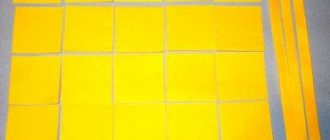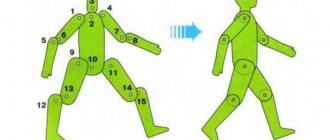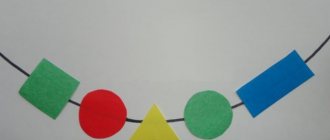2.2. What agricultural machines help people grow bread?
Children about the tractor
This material is especially interesting for boys!
Tell your child that before there were no cars and it was very difficult to grow bread. Nowadays, all the heavy work is done by machines. And a lot of them are needed to grow grain in the field and harvest. People have come up with amazing machines. Maybe when you grow up, you will also come up with something that will help all people.
The main machine is a tractor.
Why the main one? (Listen to the child's suggestions.)
A tractor is an amazing machine that moves its own path. You will learn how the tractor does this from the story (I give the text here based on the story by A. Ivich).
The tractor carries all the implements used to cultivate the land. This is a tractor.
What is the difference between a truck and a tractor? (Listen to the child’s suggestions and give the correct answer.) A truck carries a load in its back, and a tractor pulls the load behind it.
But the tractor is not a simple tractor, but an all-terrain vehicle.
Why do you think a tractor can be called an “all-terrain vehicle”? That's right, because he “walks everywhere” - both along the road and along a plowed field.
How is it that a tractor can go everywhere, even where an ordinary car cannot go? (Look at a tractor and a car with a child - pay attention to the wheels - let the child try to guess why this happens).
The tractor has small steel rollers - four on each side. The rollers are covered with steel belts. They are made of individual links, like a chain. These tapes are called "caterpillars"
. Find the caterpillars in the picture.
The rear wheel is geared. It engages the track links and moves the belt. Rollers roll along the belt as if on rails or on a flat road.
It turns out that the tractor makes its own road. Caterpillars are his path! That’s why he’s not afraid of off-road conditions!
The tractor works in the field from early spring to late autumn. Who's sitting in the driver's seat? ( tractor driver ). He drives a tractor.
The tractor does a lot of work. In the fall, a large plow is attached to the back of the tractor .
The plow lifts and turns the top layer of soil. This is how the tractor makes a soft bed for the seeds. So that the seeds are hidden in the ground from the wind and can take from the ground all the juices that they need for growth.
After this, the tractor harrows . If the crops are winter, they are sown before winter and then harrowed in the fall. If the crops are spring - they are sown in the spring - then they are harrowed in the spring. A harrow is attached to the tractor
. The harrow combs the ground with its teeth like a comb.
And the work of the tractor did not end there. Now it is no longer a harrow that is attached to it, but a cultivator.
The cultivator does not have teeth, but has…. Paws. Yes, that’s what they are called – “paws”. These paws loosen the ground and pull out weeds. So that weeds do not prevent wheat from growing!
Now the tractor has done a great job! You can attach a seeder to it. The seeder puts seeds into the ground.
It turned out that the seed was in the ground, it would germinate and shoot out with a green stem. Summer will come to an end, the ears will ripen. The grains in the ears are ripe and hard - it’s time to harvest the grain.
Then another machine comes onto the field - a real giant. It's called a "harvester".
Children about the combine and combine operators. Fun educational video for kids
Previously, it was difficult for people to harvest crops - they cut the spikelets with a sickle, then tied them into sheaves, put them on a cart, and took them to thresh. And now all this work on the field is done by smart machines - giant “harvesters”. Maybe you also have a food processor in your kitchen that helps mom? And on the field the combine is different - not like a kitchen one
.
He harvests grain and is therefore called a “grain harvester.”
From a short, fun, educational video about a combine harvester for kids, your children will learn:
The grain harvest is here! They are taking him to the elevator,
where the grain is stored. The grain is then taken to a flour mill where it is made into flour. And the finished flour will be taken to the bakery. Bread will be baked from flour at the bakery. The bread will be brought to the store, and we will buy it. This is how bread comes to our table.
Who is always in care? Tractor driver
in care.
He cherishes the field, he plows and sows. Who is always in care? Who is always in care? The truck
is being taken care of.
Carries fertilizers so that plants grow. Who is always in care? Rain
in care.
It will spill in the field, Kolosok will drink. Who is always in care? The combine operator
is in care.
He removes the rye, knows no rest. Who is always in care? The baker
is in care. He is a skilled craftsman, he bakes delicious bread. Who doesn't care? Doesn't he know Rain and Main? They ate the bread and cheered up: “Thank you!” Helio Myand.
Middle group. Junior preschool age. Children 4 - 5 years old
Abstract of educational activities on modeling in the secondary group "Bread" CONSULT of organized educational activities on artistic and aesthetic development (modeling)
on the topic:
“Treats for dolls”
in the middle group Prepared and conducted by: Anna Sergeevna Usmanova, teacher of the first qualification category Purpose: To develop the ability to sculpt from ...
Summary of the final lesson “Where did the bread come from?” with children of the middle group Final lesson on the topic “Where did the bread come from ?”
with children of the middle group Goal: To consolidate
children’s about the process of making and growing bread . Objectives: To form children's ideas about bread as the main product. To provide knowledge about cultivated plants of the field (cereals)
and their...
Bread in a basket
Drawing in the senior group on this topic can be planned as follows:
1. First, children depict a basket. This can be an ordinary product woven from twigs. The child first draws the contours with a simple pencil, dividing it into sectors. Only then are small details painted over, alternating light and dark elements with each other.
2. Then, after complete drying, the bread and bagel are painted, shading the curves of the products with a lighter shade.
3. You can insert several spikelets into the basket in the background. To do this, you need to draw with a simple pencil and then paint, also alternating colors.
Such drawing in the older group on the topic “Bread” can be done using colored pencils or wax crayons. Because there are a lot of small details.
Please note: if you want to draw such a picture at home with your child, then five-year-old children should already understand the spatial arrangement of objects. What is closer is drawn in a larger size, what is further away is drawn in a small size. To draw a basket, use such an angle when the front of the wallet is located lower, not at the same level as the back side. The inside of the container is visible. You can draw a handle for it, or you can put a napkin on the bottom of the basket and draw the corners of the fabric hanging from the middle of it.
Part 3. Save bread
Ask your child why bread should be saved? And after that, read the story about bread.
M. Glinskaya “Bread”
Mom gave Grisha a large piece of bread and sent him outside. Grisha ate bread. The bread was tasty and fragrant, with a shiny crust. Soon the boy was full, but there was still a lot of bread left. Then the guys invited Grisha to play with the ball. What to do with bread? Grisha thought and threw the bread on the ground. Uncle Matvey was passing by, stopped and asked: “Who threw the bread?” -He, he! - the guys shouted and pointed at Grisha. Grisha said: “I was already full, but there was bread left. We have a lot of bread, it’s not a pity.” Uncle Matvey took off the gold star from his chest and said: “I received the Hero’s star for growing bread. And you
you trample bread in the mud.” Grisha cried: “I didn’t know what to do with the bread. I ate my fill, but he stayed…” “Okay,” Uncle Matvey agreed. “If you didn’t know, that’s a different conversation.” He picked up the bread and put it on his palm. “This piece is my work, your mother’s work, the whole village’s work.” Bread must be loved and taken care of. “I gave it to Grisha and left.” Grisha wiped away his tears and said to the guys: “I’ll eat that bread now.” “You can’t,” Sanya objected, “the bread is dirty, you could get sick.” “Where should we put the bread now?” At that time, a cart was passing along the road, and the foal Lyska was running behind the cart. “Let’s give the bread to Lyska,” Nyura suggested. Grisha handed the foal some bread. Lyska grabbed a piece, ate it instantly and didn’t leave. He stretches his muzzle towards the guys: Come on again! Axl Oh, how delicious.”
Questions for a conversation with a child about the story “Bread”:
Part 2. How bread came to the table: a story for children in pictures and tasks
Ask your child: where does our bread come from at home? That's right, from the store! Where does it come from in the store?
Listen kindly and carefully to any of your child’s assumptions - observing his speech will help you understand what your child knows and where his ideas are inaccurate or erroneous, or even non-existent! And then invite your child to learn the secrets of how bread came to our table, what amazing machines help people make bread from grains.
2.1. How does wheat and rye grow?
Bread is made from grains. But how do these spikelets with grains grow in the field? What is white bread made from? (from wheat). What is black bread made from? (made from rye).
Why are wheat and rye called “grain” plants? (They give grain). What other grain plants are there? (Corn, oats).
With your child, look at the spikelet of rye and wheat in the picture and compare them. How are they similar? (These plants have a stem, tendrils, grains, they are grains) How are they different? (Rye grains are long, and wheat grains are round. A wheat spikelet is thicker than a rye spikelet)
After that, watch a short educational video for kids about how wheat grows in a field.
Video for children “How does wheat grow?”
From this short, entertaining, educational video for preschoolers, your child will learn:
After watching the video, be sure to talk to your child about the film, ask:
In the evening or the next day, play with your children in growing bread - a dramatization of a fairy tale will help you.
Lithuanian fairy tale. How the wolf decided to bake bread
This fairy tale is very good for dramatizing and reinforcing ideas about growing bread in children. In a skit, let the child explain to the wolf how bread is grown.
First, read a fairy tale to your child, and then invite him to play it.
One day a wolf met a man in the forest and asked: “Give me bread!” The man gave. The wolf ate it and licked his lips - the bread was delicious. The wolf says to the man: “What should I do so that I always have my own bread?” Teach me! “Okay,” the man agreed and began to teach the wolf. - First you need to plow the land... - And when you plow it, can you eat? - Not yet. We need to sow rye. - And when you sow, can you eat? - Not yet. We have to wait until she grows up. - And when he grows up, can he eat? - Not yet. We need to remove it. - And when you clean it up, can you eat it? - Not yet. We need to grind it down. - And when you grind it, can you eat it? - Not yet. We need to bake bread. - When you’re done baking, can you eat it? - Can. The wolf thought, thought and said: “I’d rather not bake bread if I wait so long.” Just as I have managed without bread until now, so, apparently, I will also manage.
Variant of the game - dramatization: You can play out the plot of this fairy tale in a different way by repeating the same dialogue with different characters (as in the fairy tale “Kolobok”). Your baby goes on a trip to the forest and treats all the animals with a piece of bread. Animals like bread, and every animal wants to know how to grow it. The child tells each animal how such delicious bread is grown (lists the sequence of work). But all the animals refuse to raise it, having learned what a long and hard work it is. In the game, the child plays the role of a person who comes to the forest. And the adult is the role of all the animals in turn. Having repeated the sequence of growing bread several times in the game, your baby will definitely not confuse anything. And he will be happy to play this game, because all children love to play!
From the age of 5, a child can be introduced to agricultural machinery that helps people in their work; with how different professions of people are interconnected - combine operator, tractor driver, agronomist and others.




